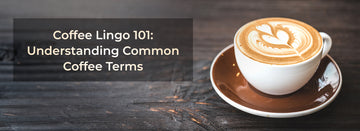Coffee Lingo 101: Understanding Common Coffee Terms
Introduction
Coffee is more than just a morning pick-me-up; it's a vibrant culture with its own unique language. If you've ever walked into a coffee shop and felt overwhelmed by the jargon being thrown around, fear not! In this Coffee Lingo 101 guide, we will demystify the common coffee terms that every coffee enthusiast should know. And what better way to embark on this journey than with Sonnets by Tata Coffee?
Let's delve into the fascinating world of coffee lingo, infused with the essence of Sonnets by Tata Coffee.
1. Espresso: The Foundation of Coffee

Let's start with the fundamental building block of many coffee beverages: espresso. Espresso, the concentrated essence of coffee, is crafted by subjecting finely ground coffee beans to high-pressure hot water. The result is a small, intense shot of coffee with a rich aroma and robust flavor. Many other coffee-based drinks, such as cappuccinos and lattes, are made by adding milk and foam to espresso.
2. Arabica and Robusta: The Two Main Coffee Species
Arabica and Robusta, the two primary species of coffee beans, each possess distinct characteristics. Arabica beans are celebrated for their exceptional quality, boasting delicate flavors and a pleasing acidity that dances on the palate. Often characterized by notes of chocolate, fruit, or floral undertones, Arabica beans offer a refined and nuanced coffee experience.
On the other hand, Robusta beans exhibit a more robust and bitter profile, accompanied by higher caffeine content. These beans are commonly employed in espresso blends, where their crema-enhancing properties add depth and richness to the final cup.
At Sonnets by Tata Coffee, the significance of sourcing the finest coffee beans is well understood. That is why their range of Reserve Single Origin Limited Edition Coffees is meticulously crafted exclusively from the highest-quality Arabica beans, ensuring an unparalleled coffee indulgence with every sip.
3. Crema: The Golden Foam on Top
Crema is the golden-brown foam that sits on top of a well-pulled espresso shot. It is a mark of quality and indicates that the espresso has been properly extracted. The crema adds a creamy texture and a layer of complexity to the taste. Baristas often strive to achieve a thick, velvety crema as it enhances the overall coffee experience.
4. Single-Origin vs. Blend: The Art of Coffee Sourcing
When it comes to coffee, you may come across terms like single-origin and blend. Single-origin coffee is sourced from a specific region or farm, allowing for unique flavors that reflect the terroir and growing conditions. On the other hand, blends harmoniously merge coffee beans sourced from diverse origins, resulting in a well-balanced and consistently delightful flavor profile. Each approach has its own merits, and exploring both can open up a world of diverse taste experiences.
5. Latte Art: The Beauty in Coffee

Latte art is the practice of creating designs on the surface of espresso-based beverages, typically lattes or cappuccinos. Skilled baristas can pour milk in a way that produces intricate patterns, such as hearts, rosettas, or even elaborate drawings. The artistry of latte art not only enhances the visual allure of the coffee but also serves as a testament to the barista's meticulous craftsmanship and unwavering commitment to precision.
6. Cold Brew: A Refreshing Alternative
Cold brew has gained popularity as a refreshing alternative to traditional hot coffee. It involves immersing coffee grounds in cold or room-temperature water, allowing them to steep over an extended period, typically ranging from 12 to 24 hours. The result is a smooth, low-acidity beverage that highlights the subtle flavors of the coffee. Cold brew is often served over ice and can be customized with various syrups or milk.
7. Pour-over: The Art of Precision Brewing

Pour-over brewing is a manual coffee brewing method allowing precise control over the brewing process. It involves pouring hot water over freshly ground coffee in a filter cone, allowing the water to extract the flavors as it drips through. Pour-over brewing emphasizes the nuances of the coffee, resulting in a clean and flavorful cup.
8. French Press: Full-Bodied Immersion Brewing
The French press, also known as a plunger or press pot, is a classic brewing method that produces a full-bodied and robust cup of coffee. It involves steeping coarse coffee grounds in hot water for several minutes and then pressing a mesh plunger to separate the grounds from the brewed coffee. The French press method allows the oils and flavors to be fully extracted, resulting in a rich and aromatic brew.
Conclusion
Congratulations! You've now been introduced to some of the key coffee terms that will help you navigate the fascinating world of coffee. From understanding the difference between Arabica and Robusta beans to appreciating the art of latte design, this Coffee Lingo 101 guide has given you a taste of the diverse and vibrant culture that surrounds this beloved beverage. So, the next time you step into a coffee shop, you can confidently order your favorite drink and impress your friends with your newfound coffee knowledge. Cheers to a delicious journey into the world of coffee!
Disclaimer: Please note our products are vegetarian and the images used on this blog are for illustrative purposes only.








